How do you think your AC or refrigerator produces a cooling effect?
Various types of refrigerants are used in AC and refrigerators to provide an optimum cooling effect. However, some of these refrigerants pose a serious environmental concern that can’t be ignored. They play a significant role in depleting the ozone layer. In this article, we will compare refrigerants like R22, R32, R134a, R290, and R410a that belong to the CFC, HFC, and HCFC categories to find out which is better for air conditioners and refrigerators.
We take technology for granted and are too ignorant to be concerned about what type of refrigerant our appliances use. These refrigerants play a significant part in depleting the ozone layer that protects us from harmful UV rays.
However, if you carefully choose your air conditioner and refrigerator, you may prevent yourself from being responsible for enhancing the depletion of the ozone layer. In that case, not to worry, we’ve got you covered.
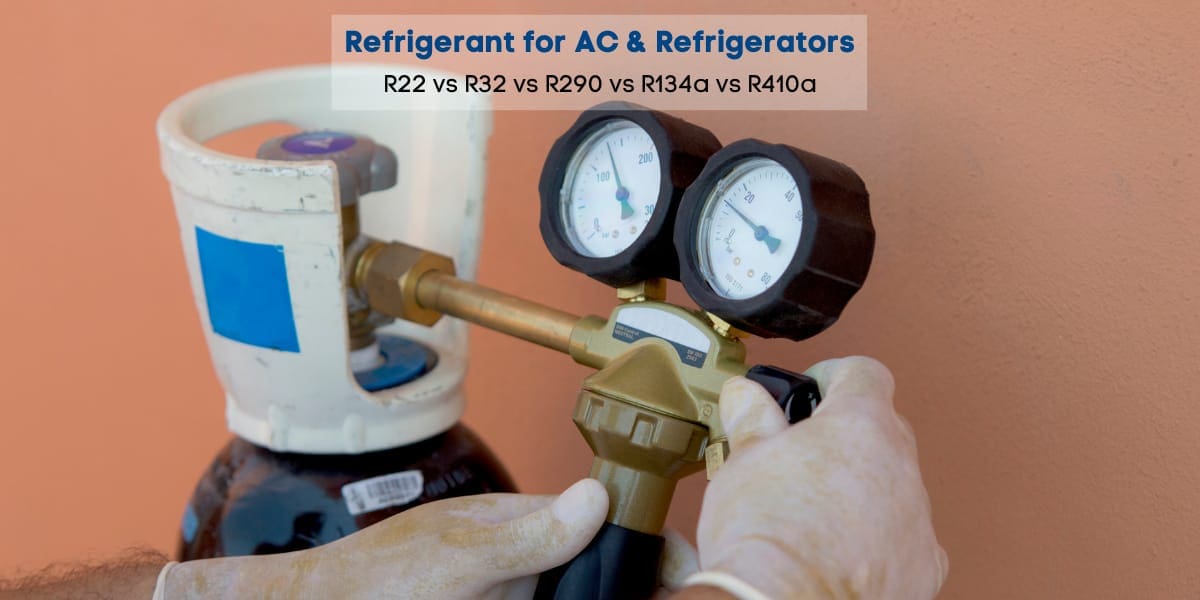
What is a Refrigerant?
A refrigerant is a substance that undergoes repeated transitions from liquid to gas and vice versa. It absorbs heat and shifts into a gaseous state when passing through the evaporator. Then it is compressed by the compressor to return to the liquid state again. These repeated transitions between states absorb heat from the working space of the appliance and release it outside the area. It is called the refrigeration cycle.
For example, the refrigerant in an air conditioner absorbs the room’s heat when the air is repeatedly recirculated. The outdoor unit contains the evaporator where the heat is dissipated. The same thing happens with a refrigerator and other similar devices.
While BEE, ISEER, EER, and COP Star Ratings are important considerations for air conditioners, refrigerants are important for both AC and refrigerators.
Refrigerants have always remained controversial since their first usage. In the category of chlorofluorocarbon, Refrigerants have an enormous negative impact on the ozone layer and the environment. The substances we use as refrigerants have evolved over the years.
From natural elements like water, Carbon dioxide, and ammonia, we have moved to chemicals like CFCs, HFCs, and HCFCs. However, consequently, the depletion of the ozone layer skyrocketed because of the dispersal of such elements into the environment.
Chemicals like CO2, Ammonia are no anymore used as refrigerants for AC and every type of fridge- single-door, double-door, or side-by-side refrigerators. CFC, HFC, and HCFC are the most widely known categories of refrigerants.
What are CFC, HFC, and HCFC?
As said, the environmental impact which CFCs (Chlorofluorocarbons) had was enormous. CFCs are the prime culprit responsible for depleting the ozone layer and greatly enhancing the greenhouse effect. Several medical authorities reported a spike in the cases of skin cancer and other diseases related to the depletion of the ozone layer.
HCFC or Hydrochlorofluorocarbon is also responsible for ozone depletion. However, world leaders and other countries were quick to notice the harmful effects of CFCs and HCFCs. If the use of CFCs as refrigerants was to continue, large-scale depletion of the ozone layer was imminent. That’s why 43 countries, including the world leaders, signed the Montreal Protocol in 1987, aiming to limit the use of CFCs as refrigerants.
Now multiple alternatives to CFCs have been found, and their (including the R12) usage has been gradually constrained. Although modern refrigerants have little to no effect on the ozone layer, research for developing less environment-damaging refrigerants is still going on.
HFC is the full form of Hydrofluorocarbon. The difference between HFC and other categories is that it does not deplete the ozone layer. But it indeed has a little global warming potential(GWP).
How do CFCs Deplete the Ozone Layer?
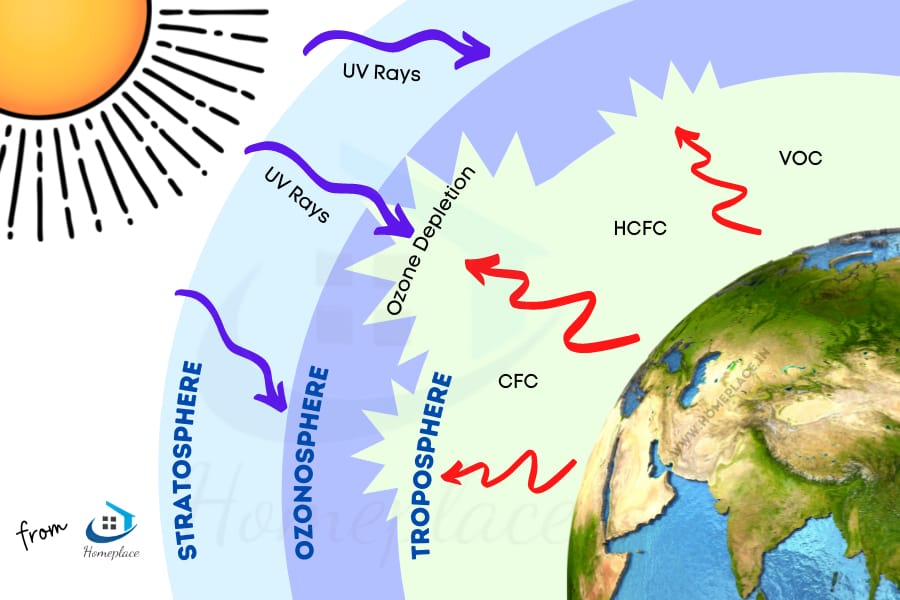
The molecules of CFC contain atoms of chlorine, fluorine, and carbon in different proportions. And, it’s the chlorine atoms in a CFC molecule that is responsible for the depletion of the ozone layer. Apart from CFC, volatile organic compounds (VOC) also contribute to the depletion of the ozone layer.
Once in the gaseous state, CFC molecules start drifting upwards until they reach the stratosphere. The UV radiation from the sun breaks down the CFC molecule and releases chlorine into the atmosphere. The chlorine atoms then react with the ozone molecule that contains 3 atoms of oxygen to form chlorine monoxide (ClO), releasing oxygen gas in the process.
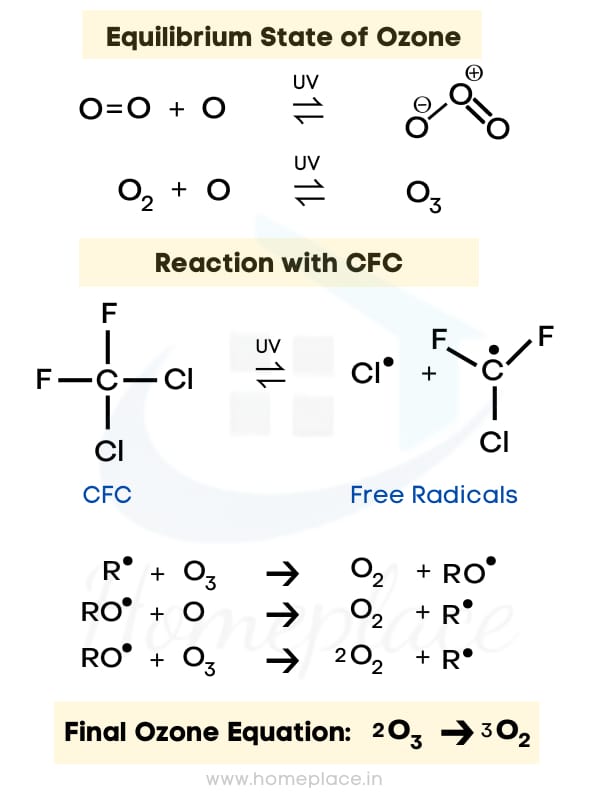
In the above image “R” denotes the Cl ion from CFC or NO from nitrogen oxides.
The reaction doesn’t stop there; the ClO molecules in the air react further with ozone molecules to form new compounds while destroying the ozone itself. Furthermore, it was found that a single chlorine atom can destroy 100,000 ozone molecules, making it hard for the ozone layer to replenish itself with the speed at which it’s being destroyed.
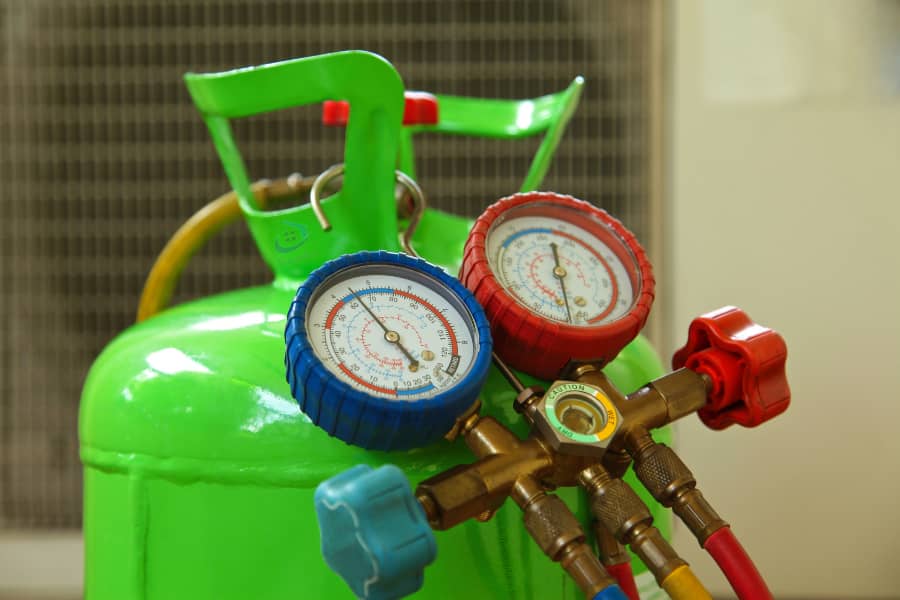
Useful Properties of Refrigerants for Refrigerators and aC
If you’re concerned about the negative environmental impacts of refrigerants, it’s essential to know what type of refrigerant your appliance is using. A good refrigerant has the following properties:
- No Toxicity: Elements such as ammonia are perfect to be used as refrigerants but are highly toxic and flammable. An ideal refrigerant should have zero toxicity. In case of accidental leakage, toxic refrigerants can be life-threatening. That’s why manufacturers mostly refrain from using ammonia as a refrigerant, especially in domestic refrigeration systems such as domestic refrigerators and ACs.
- Low GWP: If you are deeply concerned about the harmful environmental impacts of refrigerants, this should be your top priority while selecting the ideal refrigerant. The GWP or Global Warming Potential of gas measures its influence in enhancing global warming. Each gas (refrigerant) is assigned a GWP value based on its capability to trap heat. Carbon dioxide has a GWP value of 1. IPCC (Intergovernmental Panel on Climate Change) chose Carbon dioxide as the reference gas to measure the GWP of other gases. It would be best if you went with the refrigerant that has the lowest GWP. Typically, the GWP values of ozone-depleting substances range from 1 to 12,500.
- Low Freezing Point: ACs and refrigerators operate in various temperatures; the refrigerant should work ideally in every possible climate condition. That’s why the freezing point of refrigerants should be as low as possible to avoid any unwanted blockage during the flow of fluid through the evaporator.
- High COP (Coefficient of Performance): The Coefficient of Performance of a refrigerant directly influences its efficiency. A refrigerant with a low COP will increase the running cost of the refrigerant system. Similarly, a refrigerant with an exceptional COP will not only bear less load on the system (reducing the running cost), it will significantly reduce the system’s number of repairs throughout its lifetime.
- Low Miscibility with Oil: The ability of the refrigerant to mix with oil reduces the oil’s lubricating strength. This also hinders the refrigerant’s heat transfer capabilities. Elements including carbon dioxide, ammonia, and sulfur dioxide are non-miscible when compared to other refrigerants. However, miscibility is considered to be a secondary factor when choosing a refrigerant.
- A Pungent Smell: There are times when the refrigerant starts leaking from the system. In that case, it will be easy to detect the leakage if the refrigerant has a rather pungent smell.
- Low Viscosity: Viscosity should be one of your primary concerns while choosing the correct refrigerant; it should be as low as possible. A highly viscous fluid will require more energy for its circulation through the system.
- Low Flammability: Highly flammable refrigerants can cause severe problems in case of leakages. It’s better to go with a refrigeration system that uses less flammable and less explosive refrigerants. That’s why halocarbon refrigerants are considered reliable since they’re neither flammable nor combustible.
- Inertness: Inertness translates to high chemical stability. Being chemically stable means that the refrigerant will not react with the materials it comes in contact with. Meanwhile, chemical stability prevents the refrigerant from catching fire even at extreme temperatures. It also allows the refrigerant to operate ideally in vast temperature ranges.
Now, we will compare the most well-known refrigerants- R22, R290, R410a, R32, and R134a based on their properties.
Different types of Refrigerants – R22, R32, R290, R410a, R134a
Environmental concerns surrounding refrigerants are large enough to attract global attention. Using CFCs and HCFCs was prohibited all across the globe after the Montreal Protocol was carried out; scientists have focused their research on discovering refrigerants that have an even lesser environmental impact.
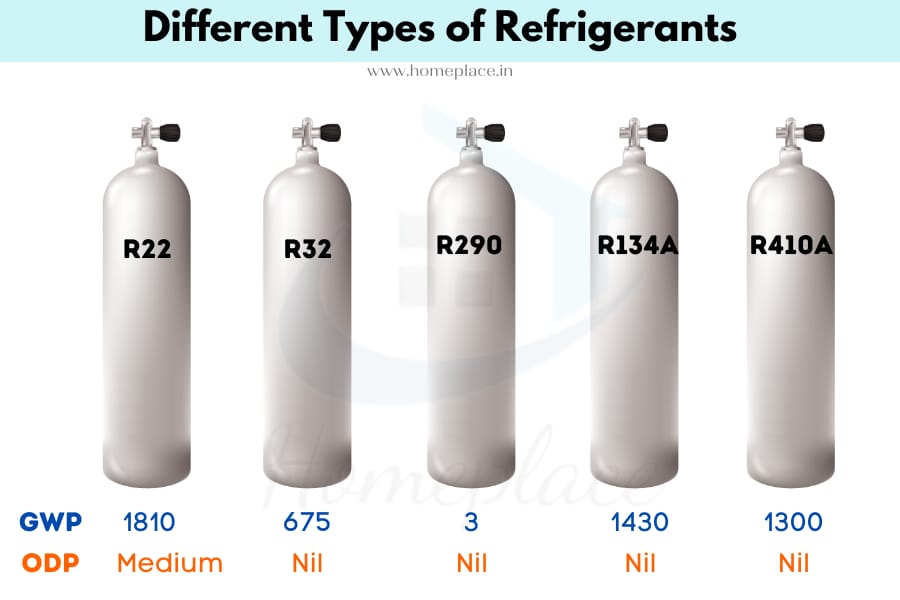
As scientists toil day and night for their research, new and more environmentally friendly substances are being discovered to be used as refrigerants in ACs and refrigerators. Here are the 5 most significant refrigerants of all time-
1. R22 Refrigerant
R22 is a CFC (chlorofluorocarbon) that was once widely used as a refrigerant in ACs and refrigerators. However, after being used extensively over many years, scientists found out that R22 significantly contributed to the depletion of the ozone layer. With a Global Warming Potential (GWP) of a whopping 1810, R22 is one of the worst refrigerants in terms of environment-friendliness.
As a result, R22 was banned from being used as a refrigerant. However, if you’re using a refrigeration system older than 10-15 years, there’s a good chance it uses R22. Check the data plate on the external condenser. If it uses R22, you should consider purchasing a new air conditioning unit that uses a modern refrigerant with a lesser environmental impact.
2. R410A Refrigerant
R410A is a zeotropic mixture of difluoromethane and pentafluoroethane, belonging to the HFC (hydrofluorocarbon) family. Although it has a zero ODP (Ozone depletion Potential), it has a high GWP of 1300 that harms the environment.
3. R32 Refrigerant
Unlike R22, R32 is an HFC (Hydrofluorocarbon) with a lesser environmental impact than R22. It does play its part in enhancing the greenhouse effect, though. Since R32 has no chlorine atoms in its molecule, it does not influence the depletion of the ozone layer.
It is primarily used as a substitute for the R410A since it can work in areas with low temperatures, unlike R410A. R32 has a safety qualification of A2L, which makes it wholly non-toxic and mildly flammable. The GWP has a low value of just 675, almost 3 times lesser than that of R22. R32 may not be utterly environment-friendly due to its potential to enhance global warming, but it’s a lot better than R22.
4. R134A Refrigerant
Carrying a low boiling point of -26.1 Celsius, R134A is an HFC refrigerant (also known as Tetrafluoroethane) that exists in a gaseous state when exposed to the environment. It is widely used as a refrigerant in domestic refrigeration systems and automotive due to its zero impact on the ozone layer coupled with its non-toxic, non-corrosive, and non-flammable nature. R134A has excellent compatibility with centrifugal, rotatory screw, scroll, and reciprocating compressors, unlike the older R12 refrigerant.
However, while having zero influence in depleting the ozone layer, R134A has a high GWP of 1410, which can’t be ignored. As a result, the European Union was the first to ban its use in automotive starting from 2011.
5. R290 Refrigerant
R290 is a hydrocarbon refrigerant possessing all the qualities of an ideal refrigerant (in terms of environmental impact). Belonging to the Propane family, R290 is highly inflammable and has multiple applications besides being used as a refrigerant. Due to its highly volatile nature, it’s widely used for heating, cooking, and drying. Chemical industries also utilize propane as a raw material for producing plastic.
As for the GWP value, it has an extremely low GWP of 3. A GWP value this low indicates that R290 plays no part in global warming. And, since it has zero ODP (Ozone Depletion Potential) value, it neither plays any role in depleting the ozone layer. Although R290 has excellent thermodynamic properties and utterly non-toxic nature, it’s highly flammable, refraining manufacturers from using propane in domestic refrigeration systems.
Comparison of R22 vs. R32 vs. R134a vs. R290 vs. R410A
You might be wondering which refrigerant is used in AC and refrigerators for the best performance. In that case, the following comparison table below should turn out to be helpful-
| Refrigerant | GWP | ODP | Toxicity | Flammability | Application |
| R22 | 1810 | Medium | Very Low | Not flammable | Not used anymore |
| R32 | 675 | Nil | Low | Mildly flammable | Automotive air conditioning and medium-temperature refrigeration |
| R134a | 1430 | Nil | Mild toxicity | Not flammable but explosive at certain oxygen levels | Automotive air conditioning and medium temperature refrigeration |
| R290 | 3 | Nil | High toxicity | Highly flammable and explosive | Commercial refrigeration and air conditioning |
| R410a | 1300 | Nil | Low | Not flammable | Domestic and commercial refrigeration and air conditioning |
From the comparison table and the 5th IPCC assessment, we can conclude that R22 should never be used as a refrigerant as it has high global warming and ozone depletion potential though it has low toxicity and is not flammable. The properties of R32 and R134a refrigerants are somehow closer. They also should never be used as they can trigger global warming.
In comparison to R22, R32, and R134a, the refrigerants like R290 and R410a have significantly lower GWP. But R290 has high toxicity and is highly combustible. on the other hand, R410a has a high GWP, zero ODP, low toxicity, and is not flammable.
Tips for choosing an appliance (AC/ refrigerator) with a harmless refrigerant
These tips can help you choose better-quality refrigerants having little to no environmental impact. These are also applicable to all types of air conditioners like portable AC, Split AC, Window AC, Hot and Cold AC, and tower air conditioners.
- Check the Year of Manufacture: Be double sure the appliance you’re purchasing wasn’t manufactured before 2010. Older refrigeration systems used R22 as a refrigerant which had a tremendous environmental impact.
- Look Carefully at the Specifications: Manufacturers have to mention all the customers’ specifications. Check if the appliance is using a safer and environmentally neutral refrigerant.
- Research Thoroughly: Before purchasing an appliance utilizing a particular refrigerant, thoroughly research its impact on the environment. Make sure to consider other factors such as toxicity and flammability of the refrigerant.
The bottom line
So, this was our take on refrigerants used in ACs and refrigerators. Technology has changed how we perceive things. Due to rising environmental concerns, toxicity and flammability are no longer the primary concerns for refrigerants.
Being neutral to the environment is the primary trait that a refrigerant must have to qualify for idealism. We haven’t yet discovered a truly ideal refrigerant that’s neutral to the environment and carries non-toxic and non-flammable properties. However, we will surely come up with a perfect refrigerant that’s, in every aspect, safe for humans and the environment alike.
Related:
